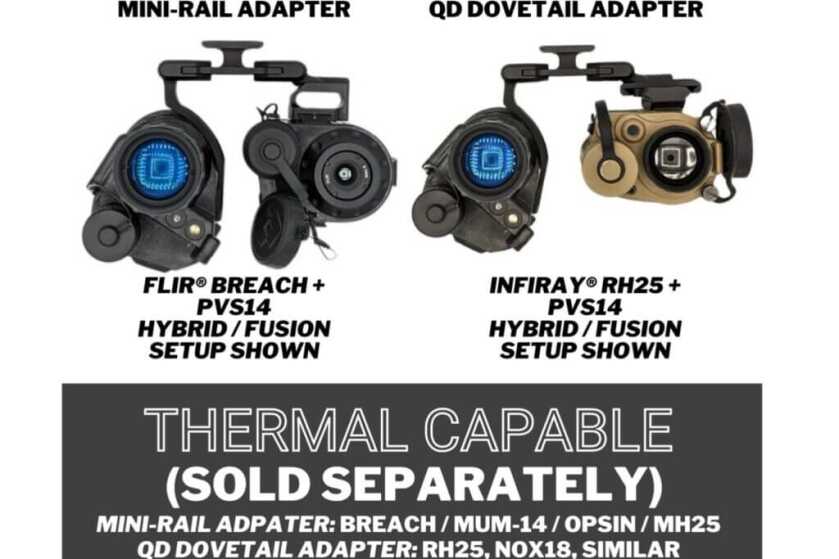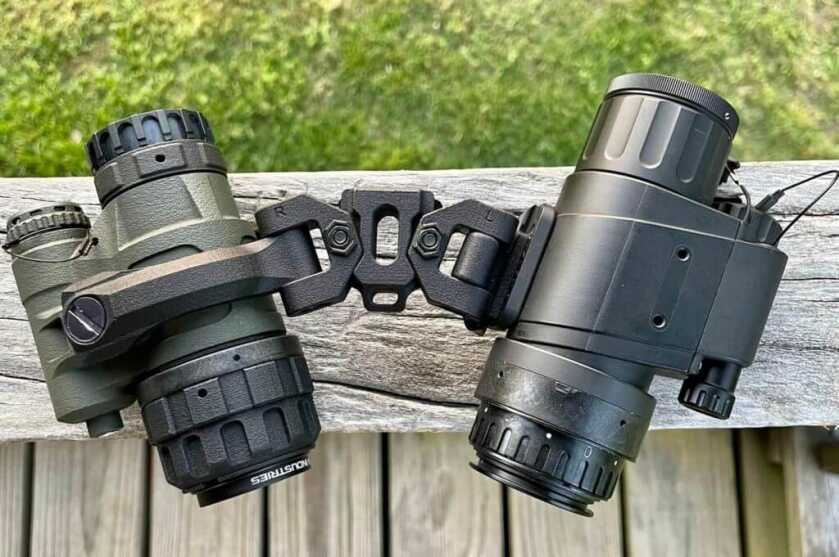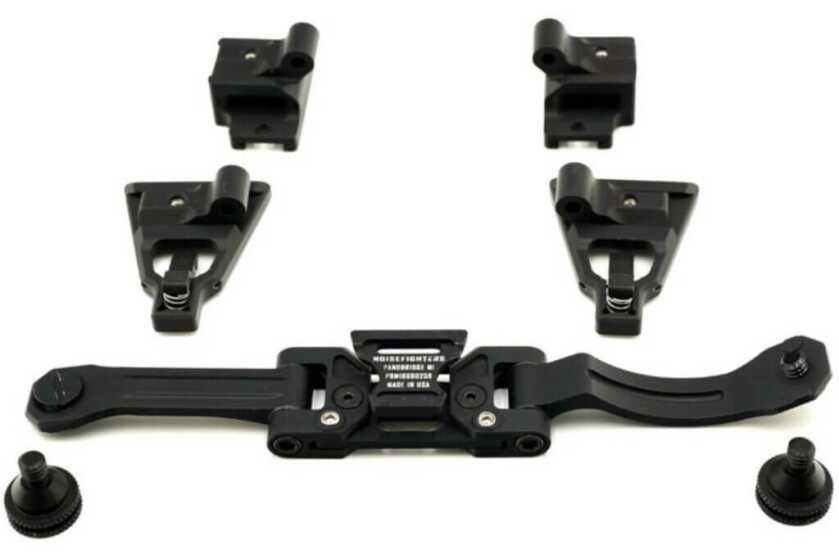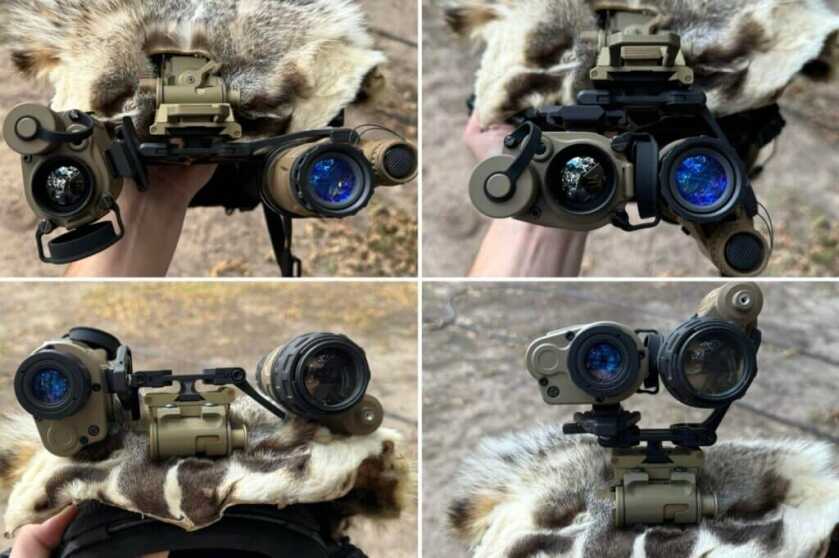Estimated reading time: 0 minutes
For those tracking advancements in night vision technology, the Noisefighters Panobridge M1 marks a significant leap in dual night vision mounting solutions. Known for their innovation, Noisefighters has once again delivered with the M1, building on the success of their earlier polymer Panobridge. This latest model refines the Adjustable Field of View (AFOV) mechanism and integrates it into a remarkably lightweight and durable metal frame.
Table of contents
Weighing just 1.9 oz, the Panobridge M1 offers the perfect balance of ultralight design and necessary strength, appealing to both night vision enthusiasts and professionals alike. In addition to the M1, the Panobridge M-series includes the M-Seven with a fixed wide field of view and the M-Zero, which maintains a traditional narrow FOV.

Versatility and Mounting
One standout feature of the M1 is its compatibility with both night vision and thermal devices. Noisefighters offers adapters that enable users to mount thermal monoculars like the FLIR Breach or InfiRay RH-25 alongside PVS-14s, opening up new possibilities for mixed NV and thermal operations. The M1 also allows for independent articulation of each monocular, so one can be stowed while the other remains in use, helping balance the system and reduce snag hazards when the NODs aren’t deployed.

I’ve been using an InfiRay MH25 thermal monocular paired with a Nocturn Industries Tanto (a lightweight PVS-14) mounted on the original polymer Panobridge for a few years now. After several hundred hours of use, I found the polymer version could loosen slightly over time. However, the new metal M1 feels much more rigid and has maintained its initial retention settings.

Adapters On the Panobridge M1
It’s worth noting that the M1 is not compatible with bayonet-style helmet mounts—it requires a dovetail-type mount. Thankfully, options like the Wilcox G24 Lite make this an easy switch, ensuring compatibility with the M1’s dovetail attachment system. Noisefighters also offer a variety of adapters to configure the M-series with different NV and thermal combinations. Currently, I have mine set up with a Nocturn Industries Tanto and an InfiRay RH-25, using Noisefighters’ metal QD and Tanto adapters.

Durability and Weight
The Panobridge M1 is constructed from 7075-T6 aluminum, providing excellent strength and durability. Noisefighters have tested its toughness by dropping it from two meters onto concrete with PVS-14s attached, proving it can handle real-world abuse. Despite its robust build, the M1 weighs the same as a standard polymer J-arm, making it one of the lightest bridges available. When paired with two PVS-14s, the total system weight remains manageable at 23.6 oz—or as light as 16.2 oz when using Nocturn Industries Tanto monoculars with lightweight lenses. For professionals requiring rugged yet lightweight gear, this is a considerable advantage.
After extensive use of the original Panobridge, I’m starting to log hours with the new metal M1. Its lightweight design significantly reduces neck fatigue during extended wear—especially for 5+ hour sessions which are typical for my nocturnal pig hunting adventures. The reduced front weight also means fewer counterweights are needed for a balanced helmet setup. I’ve eliminated counterweights, using just an external power bank in a TNVC Mohawk attached to the back of my helmet. This not only saves weight but also dramatically extends the runtime of power-hungry thermal devices.

Why Panoramic Night Vision?
Traditional dual monocular setups or single PVS-14 configurations offer a fixed 40-degree field of view (FOV), which requires constant head movement to scan your surroundings. The Panobridge M1’s AFOV mechanism changes the game, allowing users to adjust the pan angle of their PVS-14s and increase the combined FOV up to 75 degrees. This broader view enhances situational awareness, making it easier to navigate dark environments, whether driving a vehicle, clearing a building, or scanning a large area. While I don’t use the wide FOV when pairing NV with thermal, the M1 lets me switch to a wide FOV when using two PVS-14s and revert to a narrow FOV for hybrid setups.

For those who want to see more about how the panoramic aspect of this mount works, check out my article on the original Panobridge going over it in further detail below:
SEE MORE: Panoramic Night Vision Mount? Meet the Noisefighters Panobridge MK2
M1 Field Performance and Usability
In testing, the Panobridge M1’s AFOV system proved intuitive and effective. Adjusting the pan angle on the fly allows for a quick transition from a traditional binocular setup to a wider panoramic view, depending on the task. While shooting with the tubes at full spread can be challenging, narrowing the angle to around 20 degrees offers a more practical FOV for target acquisition while maintaining enhanced peripheral vision. The friction-based mechanism for adjusting the pan angle is solid, and for those needing to lock in a specific position, a simple 3/32” hex wrench will do the trick.
The M1 also addresses collimation—the alignment of images between the two monoculars. Although the system doesn’t offer automatic collimation when adjusting the pan angle, most users will find the images merge seamlessly. However, returning the tubes to a traditional binocular setup may require slight manual adjustments to avoid eye strain.
Conclusion of the Panobridge M1
The Noisefighters Panobridge M1 is a robust, lightweight, and versatile night vision mounting system that redefines how we think about NV gear. With its AFOV technology, durable construction, and compatibility with both night vision and thermal devices, the M1 is an excellent choice for those who need top-tier performance and flexibility. Priced competitively at $500, it offers exceptional value for the features and build quality it delivers. Whether you’re in law enforcement, the military, or a serious night vision enthusiast, the Panobridge M1 is my top recommendation in the night vision bridge market.
*** Buy and Sell on GunsAmerica! ***


